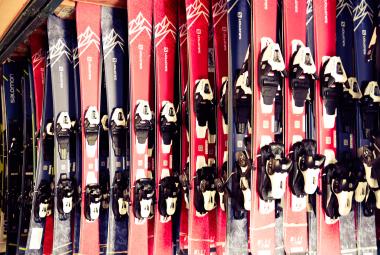Waxing skis may not be on your radar but it is just about the only maintenance your skis will need. Over time your skis may dry out, get scraps, or even get rust along the edges. The performance and longevity of your skis are dependent on the condition of the bottom of your ski.
Edging and waxing go hand in hand. Sharpening the edges of your ski will remove any burrs or rust and allow for better grip when carving. This is often done when waxing. Ideally, this is done at least once a season. If you are competitive you will want to wax prior to each event.
You can wax your own skis or you can have it done at most pro shops. Depending on the pro shop and their equipment waxing and edging can be done within 20 minutes or it can take days. You will want to check with your pro shop of choice and plan accordingly.
Waxing

There are different types of waxes for different conditions. Waxing according to ski conditions can make your skis more predictable and perform optimally. If you don’t want to wax frequently you can select an all-temperature wax. This will serve you for most of the season.
Temperature influences the quality of the snow. You can have snow with higher moisture content or you can have powder. Waxes are categorized based on the temperature range. If the temperatures bridge two different waxes you can always combine them.
Cold Waxing

This is a wax that you simply rub on your skis. Waxing skis with this technique does not last more than a few days.
It can be great for making adjustments for that one warm or cold day on a week-long trip but you won’t want it to be the only technique you use to wax your skis.
Hot Waxing

Hot waxing is a bit of an undertaking but the rewards are great. Once you have waxed your skis a few times you will find your flow. There are several tools you will need to get started waxing your own skis.
Tools
- Iron - preferably without holes, don’t take your household iron.
- Waxes
- Acrylic scrapper
- Edging tool
- Stronger rubber bands or binding bands
- Brushes - bronze wire, horsehair, or fiber brush
- Vises for skis
- Toolbox

You can buy a complete kit or build your own as your interest and excitement for waxing grows.
Step One: Clean the base. Whether you use a spray or a scraper you will want to remove grungy wax. A scraper is a flat edge that you can drag along the base of your ski. Often applying a base prep wax first will help lift any dirt and debris and prevent the base from drying out. Brush the base off with a wire brush or a fiber pad.
Step Two: Apply new wax. Your iron should be hot enough to melt the wax but that is it. If there is any smoking or smell of burning you can turn your iron down. You can melt the wax by holding the wax to the iron and allowing it to drip onto the base of the ski. Using the iron then spread the wax out from tip to tail and edge to edge.
Step Three: Scrap off any excess wax. Using your scraper, against the base of the ski make long sweeping pulls to leave only a thin layer of wax on the base. The idea is that the wax is absorbed into the base.
Step Four: Brush off the base of the ski. You can use a fiber pad or horsehair brush. Having little grooves for water and snow to pass through can reduce friction and improve speed. The warmer the weather the more or larger you will want the grooves to be.
Edging

You can check the edges of your skis by running your finger along them feeling for burs or rust. The edges should be sharp enough that you could cut your finger. You can sharpen your edges at home or you can rely on your local pro shop. Even if waxing or edging isn’t your thing, finding a regular maintenance routine, either at the end of the season or beginning of the season can greatly improve the lifespan of your skis.
Waxing skis can be a great way to ramp up your enthusiasm for the ski season. Bridging excitement from one trip to another and being invested in the care of your skis only adds to the experience of skiing. If waxing your own skis feels like another thing on the list of things to do, employing the services of a pro-shop is a great alternative.







